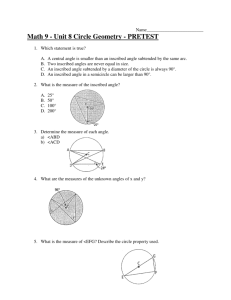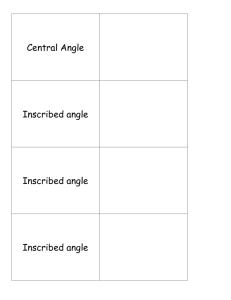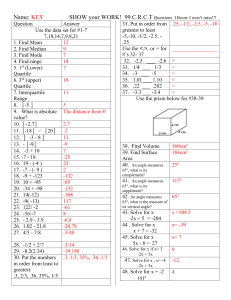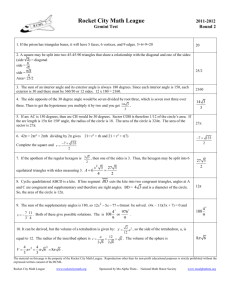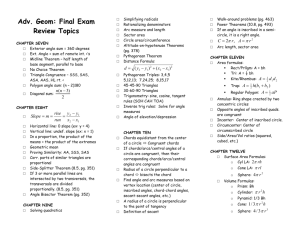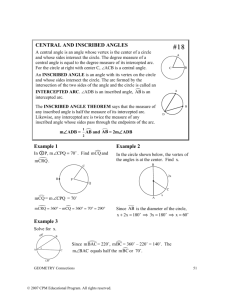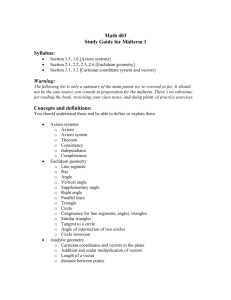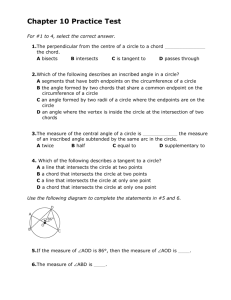Mathematics Vocabulary List For Pre
advertisement
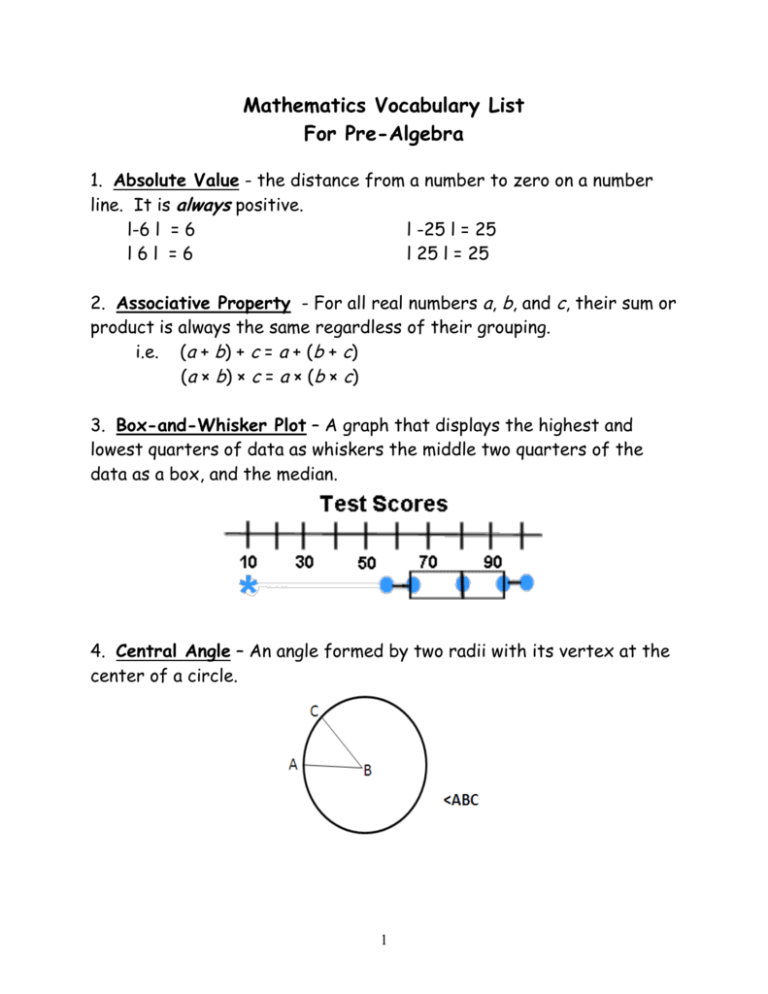
Mathematics Vocabulary List For Pre-Algebra 1. Absolute Value - the distance from a number to zero on a number line. It is always positive. l-6 l = 6 l -25 l = 25 l6l =6 l 25 l = 25 2. Associative Property - For all real numbers a, b, and c, their sum or product is always the same regardless of their grouping. i.e. (a + b) + c = a + (b + c) (a × b) × c = a × (b × c) 3. Box-and-Whisker Plot – A graph that displays the highest and lowest quarters of data as whiskers the middle two quarters of the data as a box, and the median. 4. Central Angle – An angle formed by two radii with its vertex at the center of a circle. 1 5. Chord - any segment that has its endpoints on the circle. 6. Combination - a selection of items in which order is not important. Pick 2 players for a team from a group of 5: Jim, Al, Bob, Zoe, Paige 1. Make a list: J,A A,B B,Z Z,P J,B A,Z B,P J,Z A,P J,P 2. Use Factorials: 5C2 = . 5! . (5-2)! • 2! 7. Commutative Property – States that two or more numbers can be added or multiplied in any order and still arrive at the same sum or product. i.e. 8 + 20 = 20 + 8 7 • 12 = 12 • 7 8. Congruent - two figures that have the same shape AND the same size. 2 9. Dilation – A transformation in which a figure is enlarged or reduced using a scale factor. 10. Distributive Property – If you multiply a sum by a number, you will get the same result if you multiply each addend by that number and then add the products. i.e. 4(7 + 6) = 4(7) + 4(6) 11. Experimental Probability – The ratio of the number of times an event occurs to the total number of trials, or times that the activity is performed. i.e. I rolled a 6-sided dice 10 times and got 1, 6, 3, 4, 1, 2, 3, 5, 1, 4. The experimental probability of rolling a 1 was 3/10, 0.3 or 30%. 12. Exponent - a raised number that tells the power of the base. i.e. 4³ = 4 • 4 • 4 = 64 6² = 6 • 6 = 36 13. Factorial - The product of all whole numbers except zero that are less than or equal to a number. i.e. 4 factorial = 4! = 4•3•2•1 = 24 0! is defined to be 1 3 14. Function – An input-output relationship that has exactly one output for each input. i.e. f(x) = x2 + 1 x y -2 5 0 1 1 2 15. Fundamental Counting Principle - If one event has m possible outcomes and a second event has n possible outcomes after the first event has occurred, then there are m • n total possible outcomes for the two events. i.e. A password has 2 letters and 2 numbers. If repeating is allowed, how many passwords are possible? 26•26•10•10 = 67, 600 16. Identity Property – Has 2 parts. The sum of any number and Zero is that number. The product of any number and One is that number. i.e. 8 + 0 = 8 45(1) = 45 17. Inequality – A mathematical sentence that shows the relationship between quantities that are not equivalent. i.e. 5 ‹ 8 5b + 2 ≥ 12 4 18. Inscribed Angle – An angle formed by two chords with its vertex on a circle. 19. Integers - the set of positive whole numbers, negative whole numbers and zero. i.e. …-4, -3, -2, -1, 0, 1, 2, 3, 4… 20. Intersected Arc – The arc formed due to an inscribed angle. 21. Irrational Number – A number that cannot be expressed as a ratio of two integers or as a repeating or terminating decimal. i.e. 4.45683127406792103694396… ∏ = 3.14159265358979323846… 22. Iterative Pattern – A sequence of numbers that create a repeating pattern that can be written with an input/output model. i.e. 17, 20, 23, 26, 29, 32… 3N + 14 = next term in pattern. 5 23. Linear Equation – An equation whose solutions form a straight line on a coordinate plane. i.e. y = 2x + 1 24. Mean - In a numerical data set, the sum of all the data divided by the number of data items. i.e. Find the mean of the following data: 12, 45, 32, 15, 40, 25, 29, 49, 22, 27, 31, 33, 31 1. 12+45+32+15+40+25+29+49+22+27+31+33+31 = 391 2. 391 ÷ 13 = 30.076923 3. Round to the hundredths place = 30.08 25. Median - the middle item in a data set ordered from least to greatest. i.e. Find the median of the following data: 12, 45, 32, 15, 40, 25, 29, 49, 22, 27, 31, 33, 31 1. Arrange data from least to greatest 12, 15, 22, 25, 27, 29, 31, 31, 32, 33, 40, 45, 49 2. Find the center # 31 26. Mode - the item or items that appear the most often in a data set. i.e. Find the mode of the following data: 12, 45, 32, 15, 40, 25, 29, 49, 22, 27, 31, 33, 31 The # that appears the most is 31. 6 27. Permutation - A possible arrangement of a group of items in which order is important. i.e. List all the possible arrangements for the letters D O G. DOG DGO ODG OGD GDO GOD Or you can use factorials. There are 3 possible letters. So just do 3! which is 3 • 2 • 1 = 6 possible arrangements to come up with. 28. Probability - a number from 0 to 1 that tells how likely an event is to happen. i.e. What is the probability that I will get “heads” when I flip a coin? 1 out of 2, 50%, 0.5, 1:2, ½ 29. Proportion – An equation that states that two ratios are equivalent. i.e. 5 = 25 12 60 30. Pythagorean Theorem – In a right triangle, the square of the length of the hypotenuse is equal to the sum of the squares of the lengths of the legs. a² + b² = c² i.e. 7 31. Range - The difference between the greatest data value and the least data value in a data set. i.e. Find the range of the following data: 12, 45, 32, 15, 40, 25, 29, 49, 22, 27, 31, 33, 31 The largest data item is 49. The smallest data item is 12. Subtract the two: 49 – 12 = 37. Therefore the range is 37 for this data set. 32. Rational Number – Any number that can be expressed as a ratio of two integers. i.e. 6 can be expressed as 6, and 0.5 as 1. 1 2 33. Recursive Pattern – A sequence of numbers which are defined in terms of previous numbers in the same sequence. i.e. 3, 4, 7, 11, 18, … You need to add the previous two terms together to find the next term in the pattern. 34. Reflexive Property – A property of equality that states, “for any a, a = a.” i.e. For any 7, 7 = 7. 8 35. Scatter Plot – A graph with points plotted to show a possible relationship between two sets of data. 36. Scientific Notation - a number that is written as the product of a decimal greater than or equal to 1 and less than ten and a power of 10. i.e. Write 6,224,000,000,000 in scientific notation. 6.224 • 1012 37. Secant – A line that intersects a circle at two points. 9 38. Similar - Two figures that have the same shape, but NOT the same size. 39. Slope – A measure of the steepness of a line on a graph; the rise divided by the run. 40. Square Root – One of the two equal factors of a number. i.e. 16 = 4 • 4 or 16 = -4 • -4, so 4 and -4 are square roots of 16. 41. Tangent – A line that intersects a circle at one point. 10 42. Theoretical Probability – The ratio of the number of equally likely outcomes in an event to the total number of possible outcomes. i.e. What is the probability of rolling a 1 on a 6-sided dice? 1/6, 0.16, or 16% 43. Transitive Property – If a = b and b = c, then a = c. i.e. 5 + x = 12, 22 – x = 12, then 5 + x = 22 – x 44. Translation - a transformation that slides each point of a figure the same distance in the same direction. 45. Zero Product Property – The product of any number and zero equals zero. i.e. 3 • 0 = 0 11

